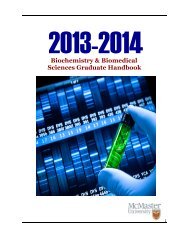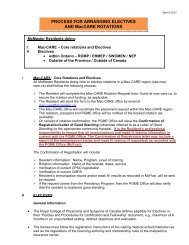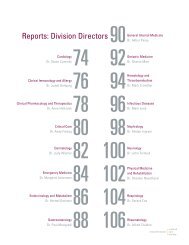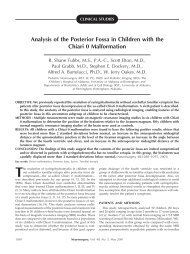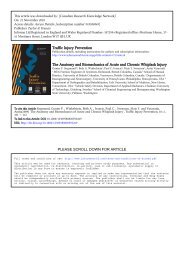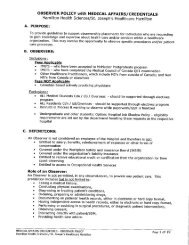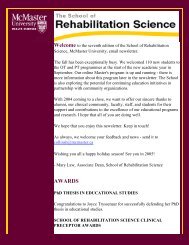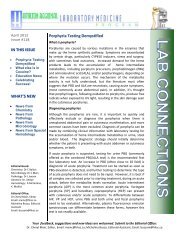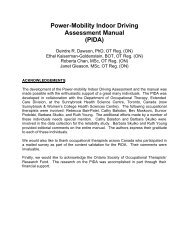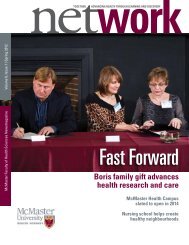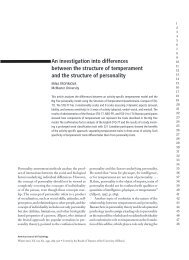Sport Med & Ortho Rehab Centre - Faculty of Health Sciences ...
Sport Med & Ortho Rehab Centre - Faculty of Health Sciences ...
Sport Med & Ortho Rehab Centre - Faculty of Health Sciences ...
You also want an ePaper? Increase the reach of your titles
YUMPU automatically turns print PDFs into web optimized ePapers that Google loves.
Idiopathic Scoliosis<br />
Devin Peterson, MD, FRCSC, Dip. <strong>Sport</strong> <strong>Med</strong>.<br />
Assistant Pr<strong>of</strong>essor , Department <strong>of</strong> Surgery<br />
<strong>Faculty</strong> <strong>of</strong> <strong>Health</strong> <strong>Sciences</strong>, McMaster University<br />
McMaster <strong>Sport</strong>s Injury Clinic
INTRODUCTION<br />
Frontal plane spinal<br />
deformity associated<br />
with torsional<br />
malalignment <strong>of</strong> the<br />
spinal column.
• Idiopathic<br />
• Neuropathic<br />
• Myopathic<br />
• Congenital<br />
• Associated with neural<br />
tissue defect<br />
• Neur<strong>of</strong>ibromatosis<br />
• Mesenchymal<br />
• Traumatic<br />
CLASSIFICATION<br />
• S<strong>of</strong>t tissue contactures<br />
• Osteochondrodystrophies<br />
• Tumor<br />
• Rheumatoid disease<br />
• Metabolic<br />
• Related to lumbosacral area<br />
• Thoracogenic<br />
• Hysterical<br />
• Functional
• Prevalence<br />
GENERAL<br />
� > 10 degrees: 1.5-3.0%<br />
� > 20 degrees: 0.3-0.5%<br />
� >30 degrees: 0.2-0.3%<br />
• Etiology Unknown<br />
• Three Types:<br />
� Infantile (0-3 years)<br />
� Juvenile (4-10 years)<br />
� Adolescent (>10 years)
• Deformity<br />
CLINICAL ASSESSMENT<br />
History<br />
� When noted<br />
� Progression<br />
� Pain<br />
• Neurologic Symptoms<br />
• Growth Indices<br />
• Family History<br />
Physical<br />
• Cutaneous back lesions<br />
� Pigmentation<br />
� Dimpling/sinuses<br />
� Hair patches<br />
• Thoracopelvic balance<br />
• Leg length discrepancy<br />
• Range <strong>of</strong> motion<br />
• Rotational prominence<br />
• Neurologic examination
• Coronal and Sagittal (3 foot<br />
standing films)<br />
� Abnormal vertebrae<br />
� Vertebral rotation<br />
� Cobb angle<br />
� Risser Sign<br />
• Convexity/pattern/major vs<br />
compensatory/structural?<br />
• Other tests as needed<br />
RADIOLOGY
• Three P’s<br />
� Progression<br />
� Pulmonary function<br />
� Psychosocial issues<br />
TREATMENT
PROGRESSION<br />
Risser Sign < 19 degrees 20 – 29 degrees<br />
0 – 1 22% progression 68% progression<br />
2 - 4 1.6% progression 23% progression
progression<br />
Thoracic Curves<br />
• Thoracic curves >60<br />
degrees<br />
PULMONARY FUNCTION<br />
� Decreased vital capacity<br />
• Thoracic curves >80<br />
degrees<br />
� Dyspnea
PSYCHOSOCIAL
treatment<br />
• Observation<br />
� Small curve (25-30 degree curve<br />
� Progression (>5 degrees)
• General:<br />
POSTERIOR INSTRUMENTATION<br />
-Instrument all vertebrae in<br />
curve<br />
-Forces should open closed<br />
disk spaces and close open<br />
spaces<br />
• Key Terms:<br />
-Neutrally rotated vertebrae<br />
-Stable vertebrae<br />
-Horizontal
Posterior instrumentation
EXPOSURE
• Thoracic Spine<br />
1. Lamina resection<br />
2. Pedicle finder<br />
3. Hook holder/pusher<br />
4. Verify position<br />
5. Mallet<br />
6. + screw fixation<br />
PEDICLE HOOKS
PEDICLE SCREWS
pedicle screws<br />
• Consider:<br />
-Transverse pedicle angle<br />
-Sagittal pedicle angle<br />
-Alterations produced by<br />
lordosis and rotation<br />
• Some margin for error
pedicle screws<br />
1. Remove outer cortex<br />
2. Pedicle finder (blunt<br />
probe)<br />
3. Flexible feeler<br />
4. Radiographs?<br />
5. CMPA
1. Remove caudal edge <strong>of</strong><br />
facet/lamina<br />
2. Hook placed medial to<br />
pedicle using hook<br />
holder/pusher<br />
3. Verify position<br />
INFRALAMINAR HOOKS<br />
Thoracic
1. Remove ligamentum flavum<br />
+ spine/ sup. facet<br />
2. Edge squared <strong>of</strong>f/bone<br />
resected<br />
3. Hook placed medial to<br />
pedicle using hook<br />
holder/pusher<br />
infralaminar hooks<br />
Lumbar
SUPRALAMINAR HOOKS<br />
1. Excision <strong>of</strong> ligamentum<br />
flavum and partial<br />
laminotomy<br />
2. Hook placement then<br />
removal
TRANSVERSE PROCESS HOOKS<br />
1. Transverse process<br />
instrument cuts<br />
costotransverse ligament<br />
2. Place hook as close to base<br />
as possible
TRANSLATION/ROTATION
COMPRESSION/DISTRACTION
• General:<br />
ANTERIOR INSTRUMENTATION<br />
-Do not instrument all<br />
vertebrae in curve<br />
-instrument vertebrae that<br />
do not come to at least<br />
neutral on the bending film
EXPOSURE
TECHNIQUE
Ref: Lovell and Winter’s Pediatric <strong>Ortho</strong>paedics (5 th edition)



